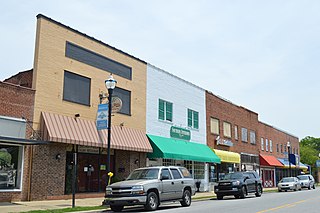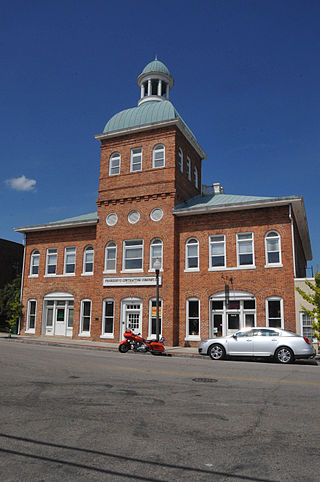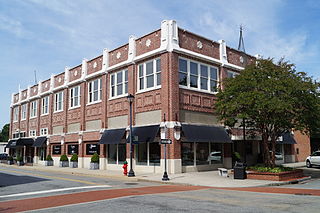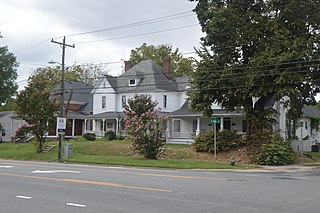
Wilson is a city in and the county seat of Wilson County, North Carolina, United States. It is the 23rd most populous city in North Carolina. Located approximately 40 mi (64 km) east of the capital city of Raleigh, it is served by the interchange of Interstate 95 and U.S. Route 264. Wilson had an estimated population of 49,459 in 2019, according to the U.S. Census Bureau, and is also an anchor city of the Rocky Mount-Wilson-Roanoke Rapids CSA, with a total population of 297,726 as of 2018.
Green Level is an unincorporated community in southwestern Wake County, North Carolina, United States. It was founded c. 1800 and is one of the best preserved crossroads communities in the county. Although historically connected to the town of Apex, Green Level now lies within the municipal jurisdiction of the town of Cary.

The New Hill Historic District is a national historic district located at New Hill, North Carolina, an unincorporated community in southwestern Wake County. The district encompasses the commercial and residential center and includes 2,820 acres (11.4 km2), 59 buildings, and one structure. The district developed between about 1860 and 1950, and includes notable examples of Colonial Revival and Tudor Revival style architecture. Notable buildings include the W. T. Roundy commercial complex, C.J. Bright's general merchandise store or New Hill Emporium, W. T. Roundy House, Duncan Lashley House, John Bright House, New Hill Baptist Church, Glass-Gardner House, and several farm complexes.

Warrenton Historic District is a national historic district located at Warrenton, Warren County, North Carolina. The district encompasses 202 contributing buildings in the central business district and surrounding residential sections of Warrenton. The district developed between about 1840 and 1926, and includes notable examples of Early Republic, Greek Revival, and Late Victorian architecture. Notable buildings include the Falkener House, Macon Street House, Peter Davis Store, Jones-Cook House, Eaton Place (1843), Sommerville-Graham House by Jacob W. Holt, Presbyterian Church also by Holt, Baptist Church, Methodist Episcopal Church, Miles Hardware Store, Warrenton City Hall, Warrenton Hotel, John Graham School, and the U.S. Post Office.
Albert Gamaliel Jones was a notable "house carpenter" from Warren County, North Carolina. He built "distinctive" Greek Revival plantation houses and college buildings.

Halifax Historic District is a national historic district located at Halifax, Halifax County, North Carolina, US that was listed on the National Register of Historic Places in 1970. It includes several buildings that are individually listed on the National Register. Halifax was the site of the signing of the Halifax Resolves on April 12, 1776, a set of resolutions of the North Carolina Provincial Congress which led to the United States Declaration of Independence gaining the support of North Carolina's delegates to the Second Continental Congress in that year.

Murfreesboro Historic District is a national historic district located at Murfreesboro, Hertford County, North Carolina. The district encompasses nine contributing buildings in the oldest section of the city of Murfreesboro. The buildings include notable examples of Greek Revival style architecture. They are the William Rea Store ; John Wheeler House birthplace of John H. Wheeler (1806-1882) and later home of Congressman Jesse Johnson Yeates (1829-1892); Myrick House ; Melrose home of Congressman William H. Murfree ; The Hertford Academy ; Roberts-Vaughan House ; Dr. Isaac Pipkin House ; Rose Bower ; and the Walter Reed House childhood home of Walter Reed.
Merge to Fairfield, Hyde County, North Carolina?

Downtown Sanford Historic District is a national historic district located at Sanford, Lee County, North Carolina. It encompasses 53 contributing buildings in the central business district of Sanford. The district includes notable examples of Colonial Revival, Tudor Revival and Art Deco style architecture, with buildings largely dated between about 1895 to 1930. Located in the district are the separately listed Railroad House and Temple Theatre. Other notable buildings include the Sanford Buggy Company, McCracken Building, Passenger Depot, City Hall, Coca-Cola Bottling Company, Masonic Lodge, Makepeace Building (1924), Wilrick Hotel (1925), Bowers Building, Cole Pontiac Building, Hubbards Shoe Store (1926), Carolina Hotel (1930), and former U. S. Post Office.

Lee Avenue Historic District is a national historic district located at Sanford, Lee County, North Carolina. It encompasses 70 contributing buildings in the historic village of Jonesboro, now part of Sanford. The district includes notable examples of Bungalow / American Craftsman style architecture, with buildings largely dated between about 1882 to the 1940s. Notable buildings include the Pierce-Seawell House, Barnes House, Jonesboro Methodist Church Parsonage, Lonnie Thomas House (1941), and Jonesboro Baptist Church (1950).

Elizabeth City Historic District is a national historic district located at Elizabeth City, Pasquotank County, North Carolina. The district encompasses 592 contributing buildings, 1 contributing site, 1 contributing structure, and 1 contributing object in the central business district and surrounds residential sections of Elizabeth City. The district developed after 1789, and includes representative examples of Greek Revival, Federal, and Late Victorian style architecture. Notable contributing buildings include the Grice-Fearing House (1789-1808), Shirley Armstrong House, Goodman-Matthews-Pool House, Dr. William Martin House, Pool-Kennedy-Lumsden House, Charles-Hussey House, Richardson-Pool House, North Carolina Building (1859), Cobb Building, the former First Methodist Church, Christ Episcopal Church (1857), J. W. Dent House, Dr. Butt's Drug Store, the McMullen Building, the Lowrey Building, former Citizens Bank, Robinson Building (1903), Kramer Building (1909), Selig Building (1925), the Virginia Dare Hotel and Arcade (1927), First Baptist Church (1889), United States Post Office and Courthouse, and Pasquotank County Courthouse (1882).

Greenville Commercial Historic District is a national historic district located at Greenville, Pitt County, North Carolina. The district encompasses 51 contributing buildings in the central business district of Greenville. It includes buildings dated from about 1914 to 1952 and notable examples of Greek Revival and Queen Anne style architecture. Located in the district and listed separately are the Pitt County Courthouse (1911) by Milburn, Heister & Company and U.S. Post Office (1913). Other notable buildings include the Proctor Hotel (1911), Montgomery Ward Department Store (1929), Dail-Hodges Building (1919), Blount Building (1924), Greenville Bank and Trust, Smith Electric Building, Greenville Municipal Building (1929) designed by Benton & Benton, Blount-Harvey Department Store (1923), White's Theater (1914), Charles Greene House (1860), and the Robert Lee Humber House (1895).

Lumberton Commercial Historic District is a national historic district located at Lumberton, Robeson County, North Carolina. The district encompasses 64 contributing buildings and 1 contributing site in the central business district of Lumberton. It includes buildings built between about 1840 to 1941 in a variety of popular architectural styles including Classical Revival and Streamline Moderne. Located in the district are the separately listed Carolina Theatre and Planters Building. Other notable buildings include the Proctor Law Office, McLeod Building (1879), (former) National Hotel, (former) Efird's Department Store, Huggins Star Shoe Shop, National Bank of Lumberton (1914), Dresden Cotton Mills Office Building, (former) Lumberton Municipal Building (1917), and Stephens Funeral Home (1936).

North Main Street Historic District is a national historic district located at Salisbury, Rowan County, North Carolina. The district encompasses 123 contributing buildings in predominantly residential section of Salisbury. It largely developed between about 1900 and 1930, and includes notable examples of Late Victorian, Colonial Revival, and Bungalow / American Craftsman style architecture. Notable buildings include the Henderlite-Kluttz House, Hines-Norman House, J. R. Crawford House, A. G. Peeler House, Davis-Wilhelm House, Salisbury-Spencer Railway Company's streetcar barn, Trexler-McSwain Store, Barringer and Rufty General Store, and the North Main Street School, now known as the John S. Henderson School.

Salisbury Historic District is a national historic district located at Salisbury, Rowan County, North Carolina. The district encompasses 348 contributing buildings and 1 contributing site in the central business district and surrounding residential sections of Salisbury. It includes notable examples of Late Victorian, Colonial Revival, and Bungalow / American Craftsman style architecture. Located in the district are the separately listed Maxwell Chambers House, McNeely-Strachan House, Archibald Henderson Law Office, and the former Rowan County Courthouse. Other notable buildings include the tower of the former First Presbyterian Church (1891-1893), Rowan County Courthouse (1914), Conrad Brem House, Kluttz's Drug Store, Bell Building, Washington Building, Grubb-Wallace Building, Hedrick Block, Empire Hotel, St. Luke's Episcopal Church (1827-1828), Soldiers Memorial A.M.E. Zion Church (1910-1913), U.S. Post Office and Courthouse (1909), City Hall (1926), Salisbury Fire House and City Building (1897).

Downtown Elkin Historic District is a national historic district located at Elkin, Surry County, North Carolina. The district encompasses 51 contributing buildings and 2 contributing structures in the central business district of Elkin. They were primarily built between about 1890 and 1950 and include notable examples of Early Commercial and Bungalow / American Craftsman architecture. Notable buildings and structures include the Gwyn-Foard House, Hugh G. Chatham Bridge (1931), Liberty Tobacco Warehouse, Harris Building (1902), U.S. Post Office (1937) designed by the Office of the Supervising Architect under Louis A. Simon, former Elkin Town Hall (1938–1939) built by the Works Progress Administration, Dobbin's Store, and the Riverside Hotel (1915–1925).

The Waxhaw Historic District is a national historic district located at Waxhaw, Union County, North Carolina. It encompasses 93 contributing buildings, 3 contributing structures, and 1 contributing object in the central business district and surrounding residential sections of Waxhaw. The district developed between about 1888 and 1940 and includes notable examples of Commercial Style, Queen Anne, and Bungalow / American Craftsman style architecture. Notable buildings include the former Post Office (1905), Harris's store, Tyson Store, A.W. Heath Co. Mill (1905), R.J. Belk Company Store, A.W. Heath Company Stores, Weir Building, Plyler Building, Farmer's Ginning & Trading Company, McDonald Hotel (1912), Waxhaw Presbyterian Church (1929), Duncan McDonald House, and Ralph J. Belk House.

Plymouth Historic District is a national historic district located at Creswell, Washington County, North Carolina.
Mount Olive Historic District is a national historic district located at Mount Olive, Wayne County, North Carolina. The district encompasses 465 contributing buildings, 2 contributing structures, and 1 contributing object in the central business district and surrounding residential sections of Mount Olive. It developed between about 1838 and 1949, and includes notable examples of Italianate and Queen Anne style architecture. Located in the district are the separately listed former United States Post Office, Mount Olive High School (Former), Southerland-Burnette House, and Perry-Cherry House. Other notable contributing buildings are the Elms, Mount Olive Presbyterian Church (1916), Carver High School (1941), Wooten & Brothers Building, DeBrutz English House, Center Theatre (1947), Mount Olive Manufacturing Company (1914), Farrior-Wooten House, Mount Olive First United Methodist Church (1911-1913), Mt. Olive Pickle Co. Office (1920), Mount Olive Passenger Depot, and Ebenezer Apostolic Holiness Church (1850).
Lucama Municipal Historic District is a national historic district located at Lucama, Wilson County, North Carolina. It encompasses 42 contributing buildings in the railroad town of Lucama. The district developed between about 1890 to 1930 and includes notable examples of Classical Revival, Bungalow / American Craftsman, and Victorian style architecture. Notable buildings include the Will Davis Store, Jesse Lucas Store, Lucama Depot (1905), Kinchen Barnes Store, W. J. Newsome Store, Lousetta Newsome House (1887), Dr. Ben Hackney House, and Lucama Methodist Church (1915).


















